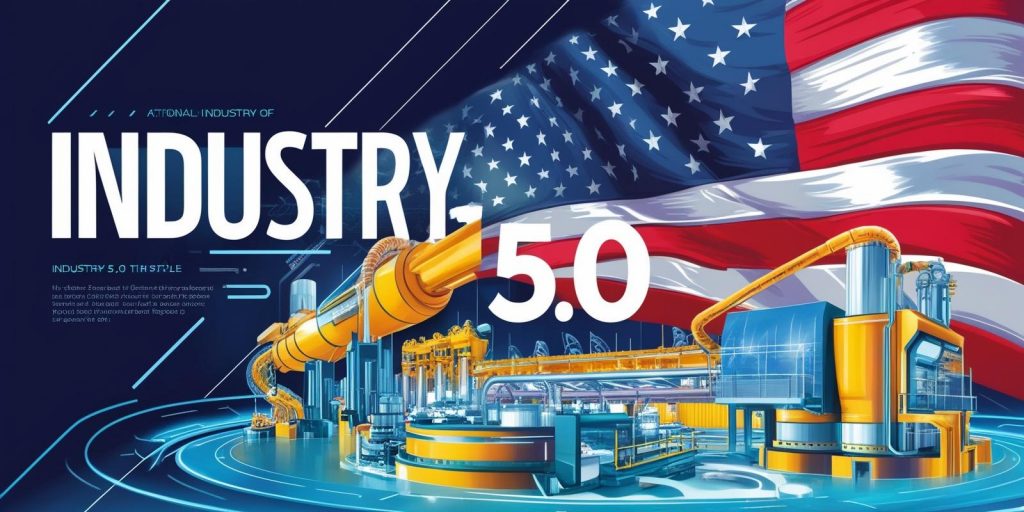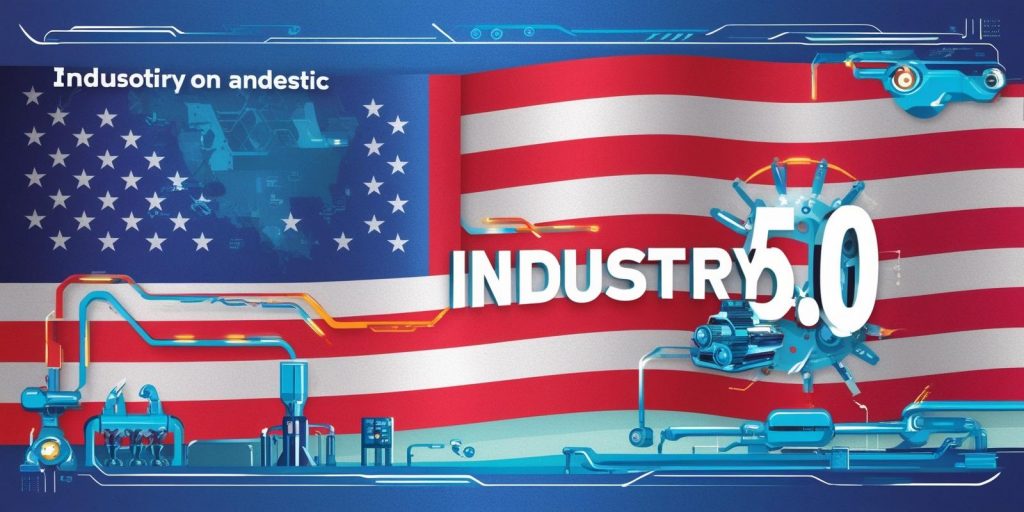The emergence of Industry 5.0—a paradigm where humans and machines collaborate harmoniously—marks a transformative phase in global industrial development. Unlike Industry 4.0, which emphasized automation, data exchange, and smart systems, Industry 5.0 brings human-centric innovation, personalization, and sustainability to the forefront. As this next industrial revolution gains traction, geopolitical dynamics, particularly the imposition of tariffs under the Trump administration, have introduced new challenges and strategic imperatives for businesses aiming to thrive in this evolving landscape.
This article delves deep into the impact of U.S. tariffs Industry 5.0 market , especially those targeting imports from China, on the Industry 5.0 market. It explores how companies are adapting their strategies, realigning supply chains, investing in technology, and reshaping their global footprints to navigate these turbulent economic waters while seizing new opportunities for growth and innovation.

Industry 5.0 extends the foundation laid by Industry 4.0 by integrating advanced technologies like AI, robotics, IoT, and big data with human creativity, intuition, and decision-making. Its key features include:
- Human-centric collaboration: Empowering workers through co-bots (collaborative robots) and intuitive interfaces.
- Hyper-personalization: Tailoring products and services to individual customer needs.
- Sustainability: Emphasizing eco-friendly production, circular economy models, and energy efficiency.
- Resilience: Enhancing supply chain and production agility to respond to disruptions.
This shift has significant implications for manufacturing, healthcare, logistics, and many other sectors, creating a demand for smarter, adaptable, and more responsive industrial ecosystems.
Beginning in 2018, the Trump administration imposed sweeping tariffs on a range of Chinese goods, citing unfair trade practices and intellectual property concerns. These tariffs, levied under Section 301 of the Trade Act of 1974, affected over $360 billion in Chinese imports, including:
- Industrial machinery
- Electronic components
- Robotics and automation equipment
- Raw materials like steel and aluminum
The immediate effect was a sharp rise in costs for U.S.-based manufacturers and tech companies that relied heavily on Chinese imports. This spurred a wave of strategic recalibrations across the industrial value chain, particularly within sectors aligned with Industry 5.0 principles.
One of the most profound impacts of the tariffs was the disruption of global supply chains. Many companies had centralized their manufacturing and sourcing operations in China due to cost advantages and supply chain maturity. Tariffs upended this model by:
- Increasing the landed cost of imported machinery and components
- Forcing companies to seek alternative suppliers in Southeast Asia, India, and Mexico
- Accelerating the nearshoring and reshoring trends for critical components
Firms pivoted toward diversified and resilient supply chains, a hallmark of Industry 5.0’s resilient framework. For example, some U.S. companies shifted production to Vietnam or Malaysia to avoid tariffs, while others invested in domestic facilities with a long-term view of supply chain sovereignty.
Request Trump Tariff Threat Assessment Analysis Now: https://www.marketsandmarkets.com/pdfdownloadNew.asp?id=35376359

The tariff shock accelerated the adoption of automation and digital transformation initiatives. Facing rising input costs, manufacturers looked to offset expenses by:
- Deploying collaborative robots to improve labor productivity
- Implementing AI-driven predictive maintenance to reduce downtime
- Adopting digital twins and real-time analytics to optimize operations
These technologies, core to Industry 5.0, allowed companies to maintain competitiveness despite higher operational costs. Furthermore, firms invested in training programs to upskill workers, ensuring human talent remained integral to increasingly automated environments.
Tariffs created a sense of urgency that pushed companies to rethink their innovation strategies. Rather than relying on low-cost imports, businesses redirected resources toward:
- In-house R&D and innovation hubs
- Partnerships with startups and universities
- Developing proprietary technologies to reduce dependency on foreign IP
Industry leaders began exploring cutting-edge solutions in flexible robotics, cognitive computing, and sustainable manufacturing practices. This reorientation aligned well with the Industry 5.0 ethos of personalization and human-centered innovation.
Another emerging trend post-tariffs is the regionalization of industrial ecosystems. Rather than global optimization alone, companies now seek regional self-sufficiency to:
- Reduce exposure to geopolitical tensions
- Shorten lead times and improve responsiveness
- Lower carbon emissions associated with long-distance transport
For instance, North American firms are developing integrated regional hubs, including R&D, production, and logistics, to serve local markets more efficiently. This approach not only counters tariff-related risks but also supports Industry 5.0 goals of resilience and sustainability.
Small and medium-sized enterprises (SMEs) and startups, often agile but resource-constrained, faced unique challenges under the new tariff regime. Increased costs and supply uncertainties put pressure on margins. However, many SMEs turned this adversity into opportunity by:
- Innovating faster to create differentiated offerings
- Collaborating with larger firms and public institutions
- Utilizing government incentives to invest in automation and digital tools
Platforms offering cloud-based AI, robotics-as-a-service, and low-code manufacturing solutions enabled SMEs to embrace Industry 5.0 without massive upfront investments.
Governments and trade organizations responded to tariff pressures with initiatives aimed at bolstering industrial competitiveness. In the U.S., policies included:
- Tax credits and grants for domestic manufacturing investments
- Funding for workforce development and STEM education
- Support for innovation clusters and technology incubators
Such measures played a vital role in enabling Industry 5.0 adoption across the economy, especially in sectors like healthcare, defense, and advanced manufacturing.
Case 1: A U.S. Robotics Manufacturer Faced with a 25% tariff on robotic components imported from China, this firm shifted sourcing to Taiwan and began manufacturing key modules in Texas. It integrated co-bots on its own production lines, enhancing efficiency while showcasing its technology to clients.
Case 2: European Automotive Supplier This company expanded its North American presence to avoid tariff exposure. It developed custom, AI-enabled manufacturing cells in collaboration with local partners, bringing mass customization capabilities closer to the end market.
Case 3: Healthcare Equipment Innovator A startup focusing on personalized medical devices accelerated its transition to MEMS-based sensors and localized production after experiencing significant delays and cost hikes due to tariffs. This move aligned with Industry 5.0’s focus on personalization and sustainability.
To succeed in the Industry 5.0 landscape post-tariffs, businesses should consider the following strategic actions:
- Redesign supply chains with flexibility, diversification, and regional resilience in mind.
- Invest in human-centric automation that enhances, not replaces, the human workforce.
- Adopt sustainability metrics as core KPIs in production and logistics.
- Foster innovation through partnerships, R&D investment, and adoption of emerging technologies.
- Engage policymakers to shape supportive trade and industrial policies.
These strategies not only counteract tariff pressures but also position firms for long-term success in the next industrial age.
The Trump-era tariffs served as both a disruptor and a catalyst for transformation in the Industry 5.0 market. While they introduced cost pressures and supply chain challenges, they also accelerated the shift toward more resilient, innovative, and human-centric industrial practices. Businesses that embraced this disruption with strategic foresight are now better positioned to lead in an increasingly complex, competitive, and sustainable global economy.
Industry 5.0 is not just about technology—it is about redefining how humans and machines collaborate to create value. In this new paradigm, the lessons learned from tariff-driven disruptions are invaluable, offering a blueprint for navigating uncertainty while building smarter, more responsive industrial ecosystems for the future.
